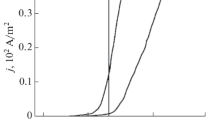Abstract
A study has been made to determine the effect of antimony, chloride ion, and glue on copper electrorefining. All deposits were made at a temperature of 65° C on a titanium cathode. Current densities of 398 A m−2 and 133 A m−2 were used. The deposits were analyzed by scanning electron microscopy (SEM) and X-ray diffraction (XRD) to determine morphology and crystal orientation. Atomic absorption (AA) and Auger spectroscopy (AES) were used to study the chemical composition of the deposits and a simple bend test was used to determine structural integrity. It was found that when the antimony concentration in the electrolyte exceeded 300 ppm, brittle deposits were produced containing considerable amounts of antimony. Very small amounts of chloride ion (1.5 ppm or above) decreased the codeposition of antimony greatly and produced ductile deposits. However, at a chloride ion level of 15 ppm or above, the back side of the deposit had a very rough, powdery appearance. The effect of glue was to counteract this and to produce a mirror-like finish on the deposit back.
Similar content being viewed by others
References
W. H. Gauvin and C. A. Winkler,J. Electrochem. Soc. 99 (1952) 71.
L. Mandelcorn, W. B. McConnell, W. H. Gauvin and C. A. Winkler,ibid. 99 (1952) 84.
Y. Yao,Trans. Electrochem. Soc. 86 (1944) 371.
V. Hospadaruk and C. A. Winkler,J. Metals 5 AIME Trans. 197 (1953) 1375.
L. F. Toth, Ph.D. thesis, University of Missouri-Rolla (1975).
V. I. Lakshmanan, D. J. MacKinnon and J. M. Brannen,J. Appl. Electrochem. 7 (1977) 81.
L. Livshits and V. Pazukhin,Zhur. priklad. Khim. 27 (1954) 298.
S. Filimonova,Tsvetnye Metal. 30 (1957) 37.
T. B. Braun, J. R. Rawling and K. J. Richards, Proc. Int. Symp. Copper Extraction and Refining, AIME, Las Vegas (1976) p. 511.
R. Taft and H. E. Messmore,J. Phys. Chem. 35 (1931) 2585.
P. K. Frolich,Trans. Amer. Electrochem. Soc. 46 (1924) 67.
E. W. Hu, W. R. Roser and F. E. Rizzo, Proc. Int. Symp. on Hydrometallurgy, AIME, Chicargo (1973) p. 155.
W. P. Lorenz, M. S. thesis, University of Missouri-Rolla (1975).
D. R. Turner and G. R. Johnson,J. Electrochem. Soc. 109 (1962) 798.
J. P. A. Wortley, presented at the 100th Annual Meeting, AIME, New York (1971).
W. M. Tuddenham, D. M. Lewis, J. M. Lebrizzi, W. A. Wood and J, Brenza, Proc. Extractive Metallurgy Div. Symp. on Electrometallurgy, AIME, Cleveland (1968) p. 223.
J. Newton and C. L. Wilson, ‘Metallurgy of Copper’, John Wiley & Sons, Inc., New York (1942) p. 392.
A. Brenner, ‘Electrodeposition of Alloys, Vol. II’, Academic Press, New York (1963) p. 560.
Author information
Authors and Affiliations
Rights and permissions
About this article
Cite this article
O'keefe, T.J., Hurst, L.R. The effect of antimony, chloride ion, and glue on copper electrorefining. J Appl Electrochem 8, 109–119 (1978). https://doi.org/10.1007/BF00617669
Received:
Issue Date:
DOI: https://doi.org/10.1007/BF00617669




